 Technology peripherals
Technology peripherals
 AI
AI
 The fidelity is as high as ~98%. The "AI + Optics" research of Guangzhou University of Technology is published in the Nature sub-journal. Deep learning empowers non-orthogonal optical multiplexing.
The fidelity is as high as ~98%. The "AI + Optics" research of Guangzhou University of Technology is published in the Nature sub-journal. Deep learning empowers non-orthogonal optical multiplexing.
The fidelity is as high as ~98%. The "AI + Optics" research of Guangzhou University of Technology is published in the Nature sub-journal. Deep learning empowers non-orthogonal optical multiplexing.

In optical multiplexing, the orthogonality between channels plays a crucial role. This orthogonality ensures that signals between different channels do not interfere with each other, enabling efficient data transmission. The optical multiplexing system can transmit multiple channels of data at the same time, effectively improving the utilization of optical fibers. However, such a system also inevitably imposes an upper limit on multiplexing capacity.
Here, the Key Laboratory of Synaesthetic Fusion Photonics Technology of the Ministry of Education of Guangdong University of Technology developed a non-orthogonal optical multiplexing on multi-mode fiber (MMF) based on a deep neural network, Called Speckle light field retrieval network (SLRnet), it can learn complex mapping relationships between multiple non-orthogonal input light fields containing information encoding and their corresponding single intensity outputs.
Through principle verification experiments, SLRnet successfully solved the ill-posed problem of non-orthogonal optical multiplexing on MMF. It is able to utilize a single shot speckle output to unambiguously retrieve multiple non-orthogonal input signals mediated by the same polarization, wavelength and spatial location with 98% fidelity. This research paves the way for realizing high-capacity optical multiplexing utilizing non-orthogonal channels and is an important step towards this goal.
This research will promote potential applications in the fields of optics and photonics and provide new insights into the exploration of broader disciplines such as information science and technology.
The related research was titled "Non-orthogonal optical multiplexing empowered by deep learning" and was published in "Nature Communications" on February 21, 2024.
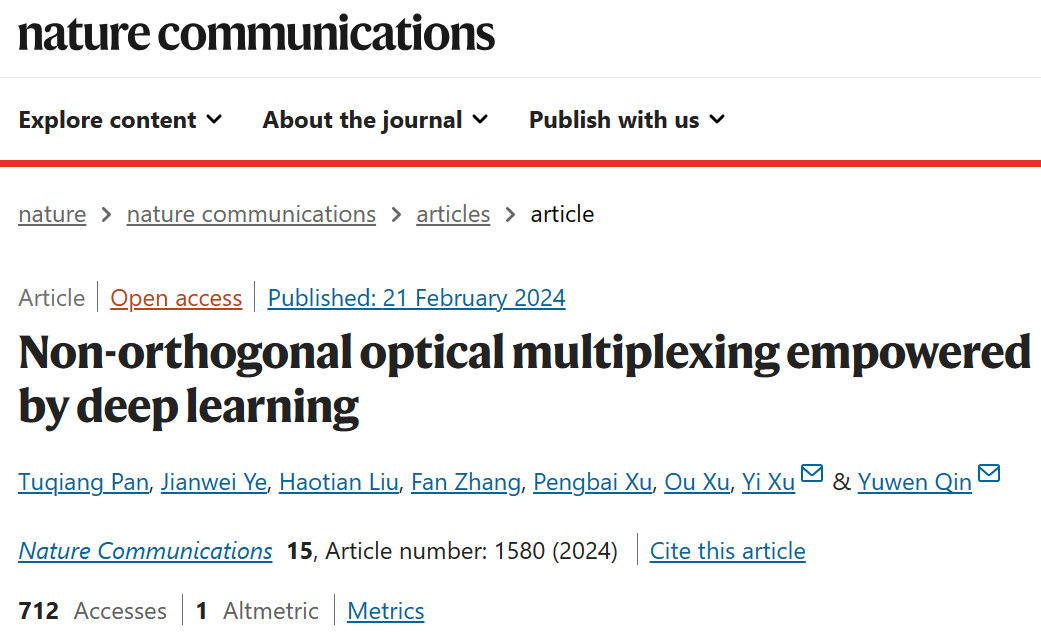
Optical multiplexing problem
Multiplexing is the cornerstone of optical communications, in which physical orthogonality between multiplexed channels is a prerequisite for large-scale coded information transmission.
Considering the demultiplexing of multiple orthogonal signals, transmission matrix methods (such as MMF) can even solve this problem on strongly scattering media.
Recently, deep learning has been widely used in the fields of optics and photonics for the reverse design of optical devices and computational optics. Specifically, deep neural networks have been used to improve the performance of orthogonal multiplexing over multiple scattering media.
However, all reported multiplexing scenarios to date strictly rely on physical orthogonality between multiplexed channels. There have been no attempts to leverage the nonlinear modeling capabilities of deep learning to achieve non-orthogonal optical multiplexing over MMFs.
Unfortunately, the multiplexing of non-orthogonal channels mediated by the same polarization or wavelength even in single-mode fiber is still very challenging due to the lack of efficient demultiplexing methods or digital signals Processing is overburdened. Therefore, developing a new method to decode the information encoded in non-orthogonal input channels is critical for eventual optical multiplexing.
Non-orthogonal optical multiplexing on MMF based on deep neural network
Here, researchers demonstrate that preliminary non-orthogonal optical multiplexing can be achieved via MMF with the support of SLRnet.
As a proof-of-concept demonstration, non-orthogonal input channels can be used to achieve multiplexed transmission of information through MMF, including general natural scene images, unrelated random binary data and images that do not belong to the same type of training data set, It is beneficial to realize non-orthogonal multiplexing transmission of optical information.
Through data-driven techniques to establish complex relationships between non-orthogonal input channels and outputs, trained deep neural networks can retrieve non-orthogonal Encoded information for traffic lanes. Even non-orthogonal multiplexed channels sharing the same polarization, wavelength and input spatial region can be efficiently decoded.
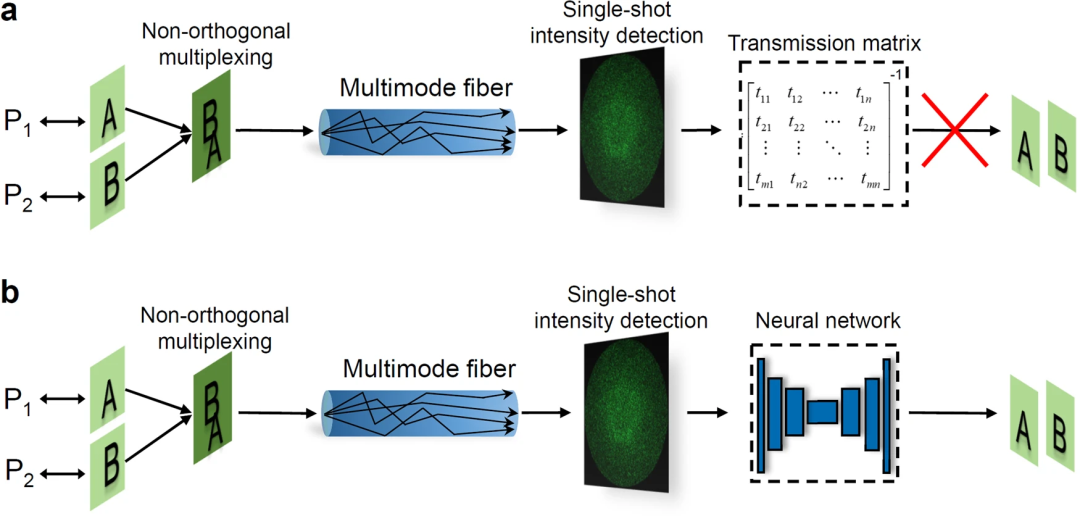
Neural Network Architecture
DepthNeural NetworkAble to retrieve non-orthogonal optical multiplexing from a single speckle output of an MMF Signal. Multiple amplitude- and phase-encoded information mediated by arbitrary polarization combinations can be efficiently retrieved by SLRnet after propagating in the MMF.
As shown in Figure 2a, even the typical scenario of non-orthogonal input channels with the same polarization, wavelength and input space region can be explicitly decoded. This is achieved through a deep neural network, the architecture of which is shown in Figure 2b, which is a variant of Unet based on the unique multiple scattering process of MMF. It consists of a fully connected (FC) layer and ResUnet.
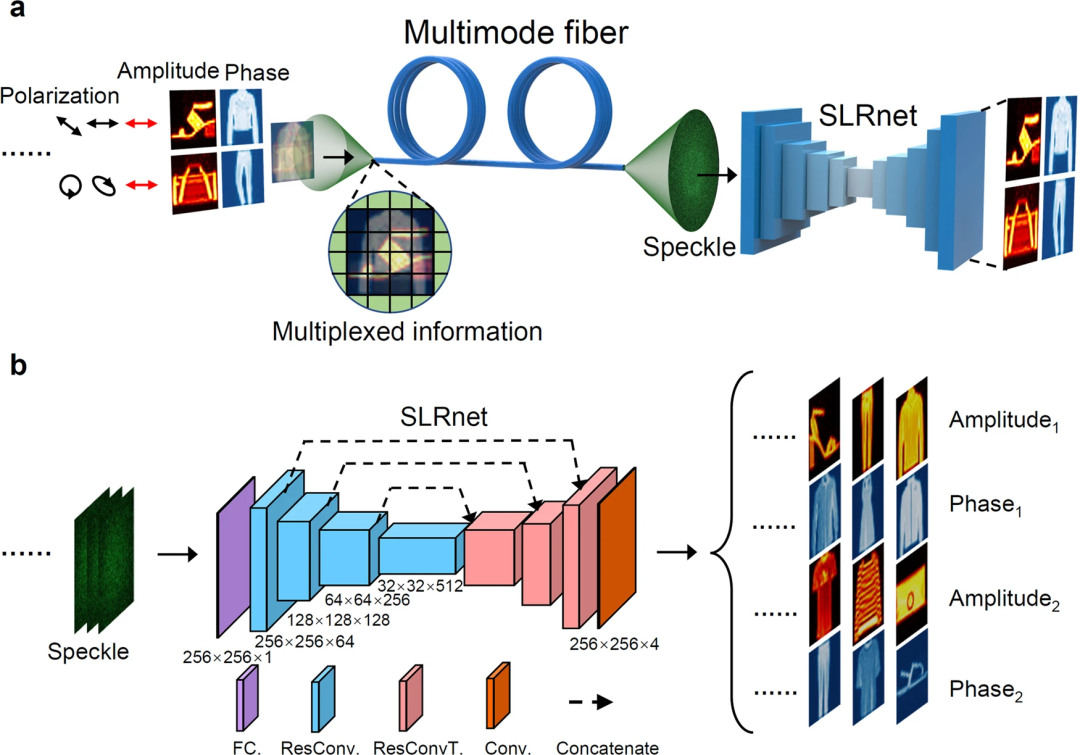
Experimental results
First consider the case where the MMF length is 1m. Figure 3a shows the evolution of the retrieval fidelity for two multiplexed light field channels with arbitrary combinations of polarization states during SLRnet training. Overall, there will be four encoding channels in the amplitude and phase dimensions, which can be non-orthogonal depending on the polarization state. Retrieval fidelity was measured by Pearson's correlation coefficient (PCC).
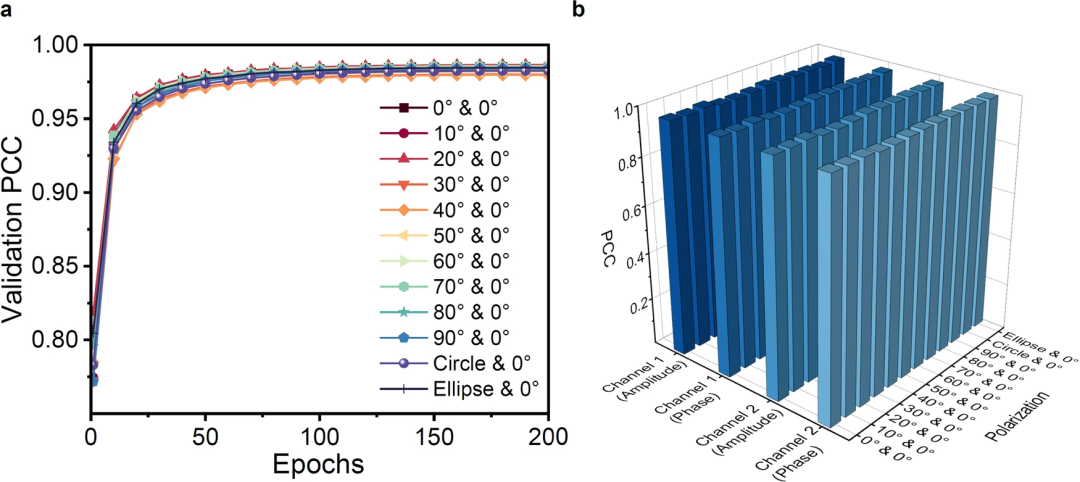
As can be seen from the figure, the evolution of PCC retrieved using the same SLRnet training configuration after 100 epochs is greater than 0.97. At the same time, the evolution of retrieval fidelity is essentially the same for the twelve multiplexing scenarios, demonstrating the excellent robustness of non-orthogonal multiplexing to arbitrary polarization combinations.
Additionally, Figure 3b provides the fidelity retrieved in each amplitude and phase multiplexed channel separately using different polarization combinations. The average retrieval fidelity in the amplitude and phase dimensions is nearly identical (~0.98), highlighting the ability of SLRnet to demultiplex information encoded in multiple non-orthogonal input channels.
In order to perform sensory evaluation of the retrieval information of wavefront encoding, the typical demultiplexing results of four polarization combinations (0° and 0°, 0° and 10°, 0° and 90°, and 0° and ellipse) are as follows: Figure 4 shows.

It can be seen that four grayscale images multiplexed on the amplitude and phase of the input wavefront using the same polarization can be effectively demultiplexed using a single speckle output. Other results retrieved with similar fidelity under different polarization combinations demonstrate that SLRnet is capable of unprecedented non-orthogonal input channel multiplexing even when the encoding wavefront is scrambled by MMF.
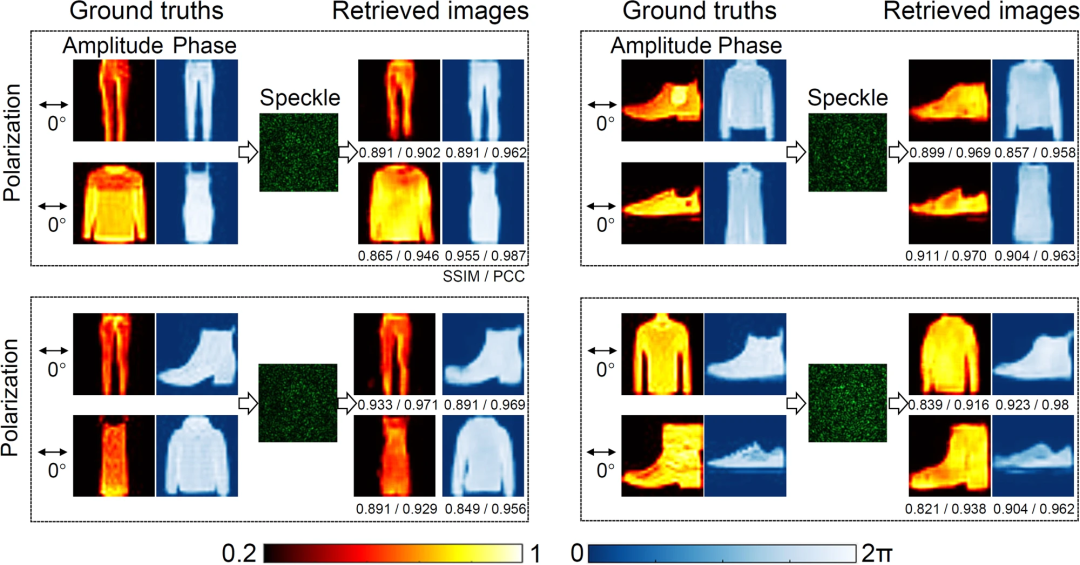
To further consolidate the superiority of SLRnet in more realistic scenarios, non-orthogonal optical multiplexing results using the same polarization state on 50 m MMF are proposed, as shown in Figure 5. As can be seen from Figures 4 and 5, the demultiplexing results for the 1 m MMF are better than the 50 m case because the scattering properties of the longer MMF are more susceptible to environmental influences. Demultiplexing performance can be further improved by optimizing the network structure. Research shows that SLRnet is an effective means of multiplexing non-orthogonal channels in MMF.
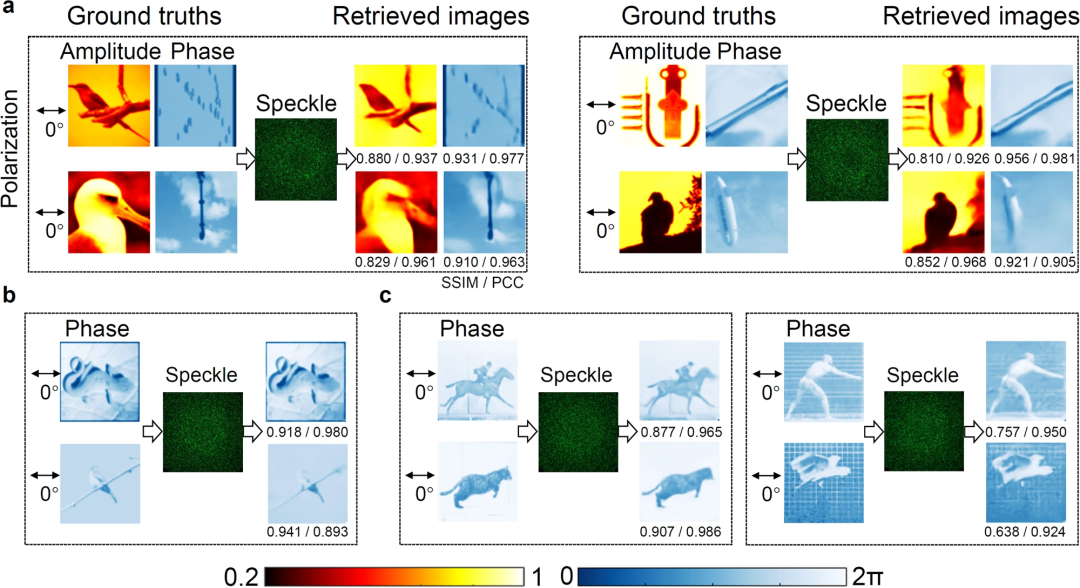
Finally, to demonstrate the versatility of SLRnet for different image sets, the study shows that SLRnet has good generalization.
Although the MMF-based non-orthogonal optical multiplexing concept proposed at this stage cannot be directly used for medical diagnosis that usually requires uniform fidelity, high-precision non-orthogonal multiplexing of non-correlated binary digital information It shows that the realization of non-orthogonal multiplexing transmission of optical information through MMF is a step forward.
This research may not only pave the way for utilizing high-throughput MMFs for communication and information processing, but may also provide a paradigm shift for optical multiplexing in optics and other fields, which can greatly increase the degree of freedom and freedom of optical systems. capacity.
The above is the detailed content of The fidelity is as high as ~98%. The "AI + Optics" research of Guangzhou University of Technology is published in the Nature sub-journal. Deep learning empowers non-orthogonal optical multiplexing.. For more information, please follow other related articles on the PHP Chinese website!

Hot AI Tools

Undresser.AI Undress
AI-powered app for creating realistic nude photos

AI Clothes Remover
Online AI tool for removing clothes from photos.

Undress AI Tool
Undress images for free

Clothoff.io
AI clothes remover

Video Face Swap
Swap faces in any video effortlessly with our completely free AI face swap tool!

Hot Article

Hot Tools

Notepad++7.3.1
Easy-to-use and free code editor

SublimeText3 Chinese version
Chinese version, very easy to use

Zend Studio 13.0.1
Powerful PHP integrated development environment

Dreamweaver CS6
Visual web development tools

SublimeText3 Mac version
God-level code editing software (SublimeText3)

Hot Topics
 Beyond ORB-SLAM3! SL-SLAM: Low light, severe jitter and weak texture scenes are all handled
May 30, 2024 am 09:35 AM
Beyond ORB-SLAM3! SL-SLAM: Low light, severe jitter and weak texture scenes are all handled
May 30, 2024 am 09:35 AM
Written previously, today we discuss how deep learning technology can improve the performance of vision-based SLAM (simultaneous localization and mapping) in complex environments. By combining deep feature extraction and depth matching methods, here we introduce a versatile hybrid visual SLAM system designed to improve adaptation in challenging scenarios such as low-light conditions, dynamic lighting, weakly textured areas, and severe jitter. sex. Our system supports multiple modes, including extended monocular, stereo, monocular-inertial, and stereo-inertial configurations. In addition, it also analyzes how to combine visual SLAM with deep learning methods to inspire other research. Through extensive experiments on public datasets and self-sampled data, we demonstrate the superiority of SL-SLAM in terms of positioning accuracy and tracking robustness.
 Breaking through the boundaries of traditional defect detection, 'Defect Spectrum' achieves ultra-high-precision and rich semantic industrial defect detection for the first time.
Jul 26, 2024 pm 05:38 PM
Breaking through the boundaries of traditional defect detection, 'Defect Spectrum' achieves ultra-high-precision and rich semantic industrial defect detection for the first time.
Jul 26, 2024 pm 05:38 PM
In modern manufacturing, accurate defect detection is not only the key to ensuring product quality, but also the core of improving production efficiency. However, existing defect detection datasets often lack the accuracy and semantic richness required for practical applications, resulting in models unable to identify specific defect categories or locations. In order to solve this problem, a top research team composed of Hong Kong University of Science and Technology Guangzhou and Simou Technology innovatively developed the "DefectSpectrum" data set, which provides detailed and semantically rich large-scale annotation of industrial defects. As shown in Table 1, compared with other industrial data sets, the "DefectSpectrum" data set provides the most defect annotations (5438 defect samples) and the most detailed defect classification (125 defect categories
 NVIDIA dialogue model ChatQA has evolved to version 2.0, with the context length mentioned at 128K
Jul 26, 2024 am 08:40 AM
NVIDIA dialogue model ChatQA has evolved to version 2.0, with the context length mentioned at 128K
Jul 26, 2024 am 08:40 AM
The open LLM community is an era when a hundred flowers bloom and compete. You can see Llama-3-70B-Instruct, QWen2-72B-Instruct, Nemotron-4-340B-Instruct, Mixtral-8x22BInstruct-v0.1 and many other excellent performers. Model. However, compared with proprietary large models represented by GPT-4-Turbo, open models still have significant gaps in many fields. In addition to general models, some open models that specialize in key areas have been developed, such as DeepSeek-Coder-V2 for programming and mathematics, and InternVL for visual-language tasks.
 Training with millions of crystal data to solve the crystallographic phase problem, the deep learning method PhAI is published in Science
Aug 08, 2024 pm 09:22 PM
Training with millions of crystal data to solve the crystallographic phase problem, the deep learning method PhAI is published in Science
Aug 08, 2024 pm 09:22 PM
Editor |KX To this day, the structural detail and precision determined by crystallography, from simple metals to large membrane proteins, are unmatched by any other method. However, the biggest challenge, the so-called phase problem, remains retrieving phase information from experimentally determined amplitudes. Researchers at the University of Copenhagen in Denmark have developed a deep learning method called PhAI to solve crystal phase problems. A deep learning neural network trained using millions of artificial crystal structures and their corresponding synthetic diffraction data can generate accurate electron density maps. The study shows that this deep learning-based ab initio structural solution method can solve the phase problem at a resolution of only 2 Angstroms, which is equivalent to only 10% to 20% of the data available at atomic resolution, while traditional ab initio Calculation
 Google AI won the IMO Mathematical Olympiad silver medal, the mathematical reasoning model AlphaProof was launched, and reinforcement learning is so back
Jul 26, 2024 pm 02:40 PM
Google AI won the IMO Mathematical Olympiad silver medal, the mathematical reasoning model AlphaProof was launched, and reinforcement learning is so back
Jul 26, 2024 pm 02:40 PM
For AI, Mathematical Olympiad is no longer a problem. On Thursday, Google DeepMind's artificial intelligence completed a feat: using AI to solve the real question of this year's International Mathematical Olympiad IMO, and it was just one step away from winning the gold medal. The IMO competition that just ended last week had six questions involving algebra, combinatorics, geometry and number theory. The hybrid AI system proposed by Google got four questions right and scored 28 points, reaching the silver medal level. Earlier this month, UCLA tenured professor Terence Tao had just promoted the AI Mathematical Olympiad (AIMO Progress Award) with a million-dollar prize. Unexpectedly, the level of AI problem solving had improved to this level before July. Do the questions simultaneously on IMO. The most difficult thing to do correctly is IMO, which has the longest history, the largest scale, and the most negative
 PRO | Why are large models based on MoE more worthy of attention?
Aug 07, 2024 pm 07:08 PM
PRO | Why are large models based on MoE more worthy of attention?
Aug 07, 2024 pm 07:08 PM
In 2023, almost every field of AI is evolving at an unprecedented speed. At the same time, AI is constantly pushing the technological boundaries of key tracks such as embodied intelligence and autonomous driving. Under the multi-modal trend, will the situation of Transformer as the mainstream architecture of AI large models be shaken? Why has exploring large models based on MoE (Mixed of Experts) architecture become a new trend in the industry? Can Large Vision Models (LVM) become a new breakthrough in general vision? ...From the 2023 PRO member newsletter of this site released in the past six months, we have selected 10 special interpretations that provide in-depth analysis of technological trends and industrial changes in the above fields to help you achieve your goals in the new year. be prepared. This interpretation comes from Week50 2023
 AlphaFold 3 is launched, comprehensively predicting the interactions and structures of proteins and all living molecules, with far greater accuracy than ever before
Jul 16, 2024 am 12:08 AM
AlphaFold 3 is launched, comprehensively predicting the interactions and structures of proteins and all living molecules, with far greater accuracy than ever before
Jul 16, 2024 am 12:08 AM
Editor | Radish Skin Since the release of the powerful AlphaFold2 in 2021, scientists have been using protein structure prediction models to map various protein structures within cells, discover drugs, and draw a "cosmic map" of every known protein interaction. . Just now, Google DeepMind released the AlphaFold3 model, which can perform joint structure predictions for complexes including proteins, nucleic acids, small molecules, ions and modified residues. The accuracy of AlphaFold3 has been significantly improved compared to many dedicated tools in the past (protein-ligand interaction, protein-nucleic acid interaction, antibody-antigen prediction). This shows that within a single unified deep learning framework, it is possible to achieve
 To provide a new scientific and complex question answering benchmark and evaluation system for large models, UNSW, Argonne, University of Chicago and other institutions jointly launched the SciQAG framework
Jul 25, 2024 am 06:42 AM
To provide a new scientific and complex question answering benchmark and evaluation system for large models, UNSW, Argonne, University of Chicago and other institutions jointly launched the SciQAG framework
Jul 25, 2024 am 06:42 AM
Editor |ScienceAI Question Answering (QA) data set plays a vital role in promoting natural language processing (NLP) research. High-quality QA data sets can not only be used to fine-tune models, but also effectively evaluate the capabilities of large language models (LLM), especially the ability to understand and reason about scientific knowledge. Although there are currently many scientific QA data sets covering medicine, chemistry, biology and other fields, these data sets still have some shortcomings. First, the data form is relatively simple, most of which are multiple-choice questions. They are easy to evaluate, but limit the model's answer selection range and cannot fully test the model's ability to answer scientific questions. In contrast, open-ended Q&A





